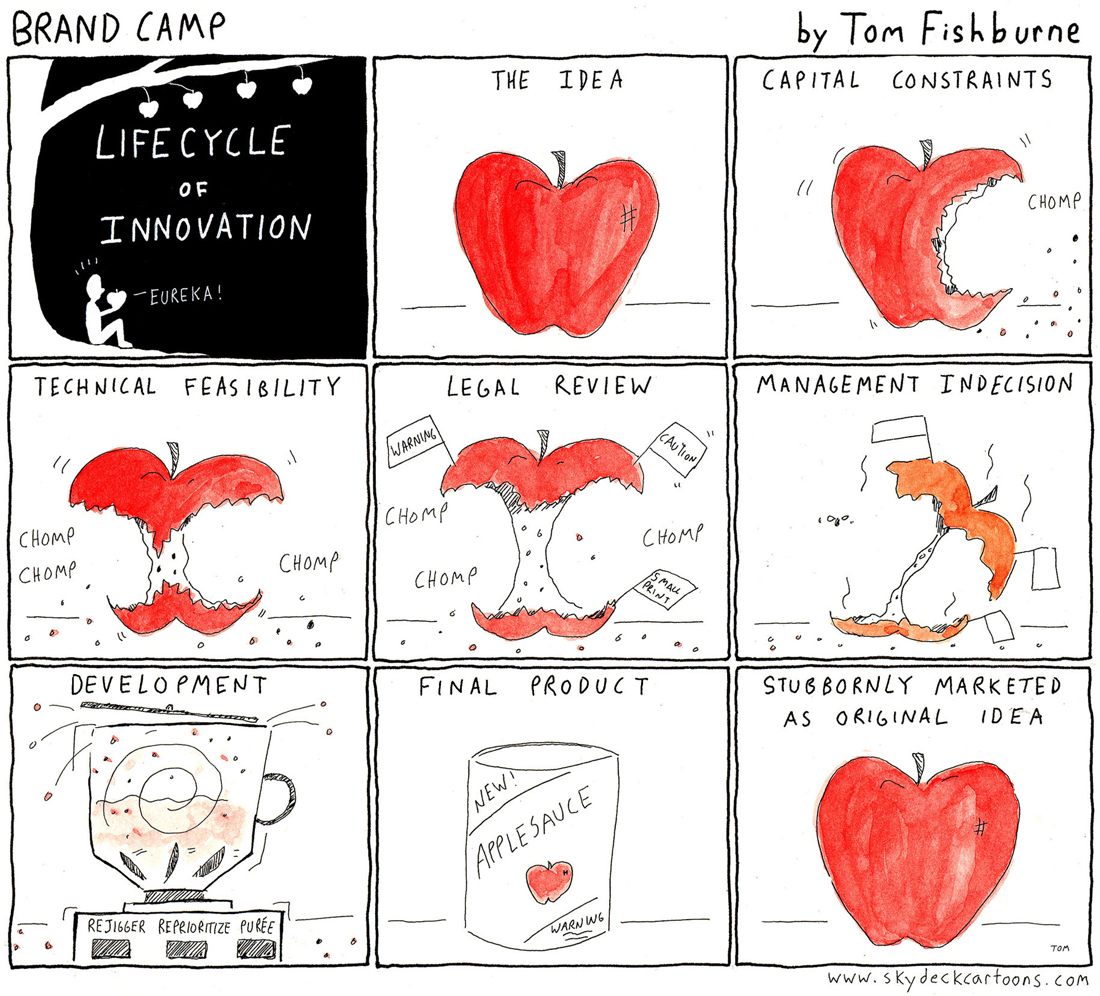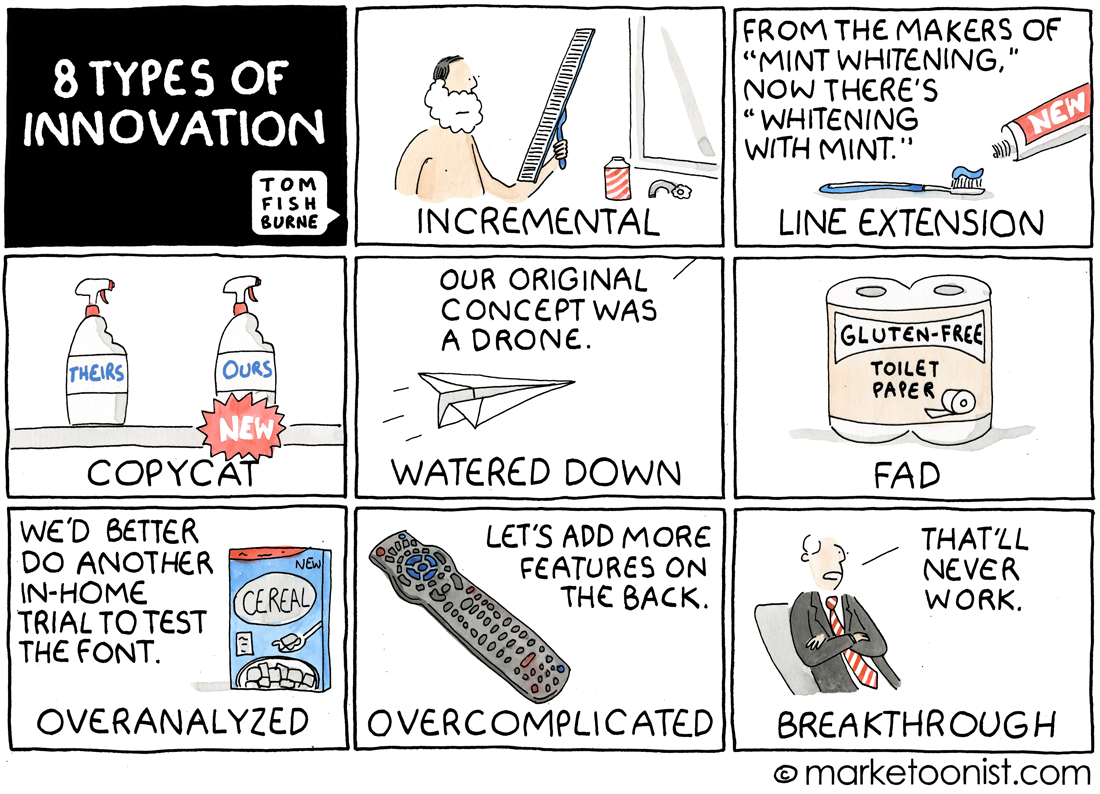In innovation, the path of least resistance usually leads to mediocrity. A form of Darwinism drives organizations as they decide which ideas to launch. But instead of “survival-of-the-fittest,” it’s “survival-of-the-safest.”
Innovation stage gates generally reward predictability, proof points, and past successes. And so the ideas that rise to the top result in more of the same. Innovation in many organizations is influenced more by risk aversion than by whether the ideas themselves are truly remarkable.
That’s how we end up with 352 distinct types or sizes of toothpaste sold at retail in the US, all claiming to whiten teeth, reduce plaque, curb sensitivity, and fight gingivitis, sometimes all at once.
Breakthrough innovation, on the other hand, carries risk, risk causes fear, and fear causes organizations to clamp down. According to BCG, only 10% of an average company’s innovation portfolio is considered breakthrough.
If we work in innovation, our job is to continually push ideas outside of the path of least resistance to the path of most remarkable. That requires taking the risks head-on and making known some of the unknown risks that can derail breakthrough projects. In innovation, playing it safe is itself risky.
Here’s one of the first cartoons I drew, back in 2002, on this theme. It imagines what happens after the apple falls on Newton’s head, the process of bringing that idea to life. The path of least resistance turns apples into applesauce. And in a cluttered world, there’s already too much of that.

I’d love to hear your thoughts on what it takes to create breakthrough innovation.



Mary Cole says
The types of innovation and lifecycle of innovation are marvelous cartoons. It seems to me (and to psychologist types I read) that the more varied information you have in your brain, the better the chance of unusually good connections being made. I think I was in high school when I first read about Watkins and Crick and their fencing which ultimately lead to recognizing the double helix. (I even learned to fence because I thought that was cool.) As a reader of things far and wide, I attribute my ability to relate to a range of people and ideas to making connections in concepts already understood. Sometimes other people in the room don’t quite appreciate new ideas, as you point out, and that may be due to their lacking exposure to component concepts. That’s part of why I support libraries and encourage young people to read anything that catches their fancy!
Christopher Brace says
Here, here, Mary! Organizations need to build a learning culture if they every hope to build a culture of innovation. The more we learn about things outside the world programmed in our non-conscious minds, the greater our chances of being innovative.
Susan Goewey says
Passion and persistence and (unfortunately) a paycheck.
Christopher Brace says
I believe what’s needed is more innovative problem identification, not problem solution. The reason we have 352 types and sizes of toothpaste is because brands are all solving the same problems over and over again, rather than finding new problems to solve.
Bob Roach says
Problem identification is often just problem creation. And for many companies, this passes for innovation. Witness the wide world of hair products and their endless offered solutions for ‘problem hair’.
Who knew that there were so many problems with hair? How did our ancestors survive? Mostly because there never really was a problem to begin with.
Allen Roberts says
Those who have the ‘thing’ that enables them to come up with the outlier ideas often get weeded out of the corporate innovation processes in our age of homogeneity and group-think, simply because they are often disturbing to the group ‘harmony’.
Without them, their ideas wither, and sink into conformity
This sameness inevitably leads to apple sauce.
Love your work Tom.
Tessa Stuart says
There is a really good Ted talk by Adam Grant on original thinkers which echoes some of Mary’s points and points out that first mover advantage is anything but. Worth 15 minutes of your time.
Working in food NPD consumer research, I see successful challenger brands like Pip and Nut nut butter innovating through sheer personal frustration. She wanted a nut butter without environment-destroying palm oil, and one she could eat on the go. She uses agave syrup and single portion squeeze packs you can take with you when you’re running.
Seedlip is another case in point, it uses all the aromatic botanicals you find in gin, but with no alcohol – the drink for when you’re not drinking.
But I have also sat through innovation workshops with publicly listed global drinks companies where any new ideas were quashed (or squashed) because of the capital expenditure write-down risk, where the risk of not innovating is the preferred option.
Sharon Green says
I agree with many of the comments here and I love your cartoons too. There are many reports that suggest that innovation and innovators often are sidelined in big organisations or corporates because they behave and think differently. They can frustrated with a lack of progress and leave or find progress slow and frustrating. I’m generalising of course. True product innovation is quite different from re-branding, refreshing or replicating existing products on the market; like the toothpaste analogy. Barriers to entry for new products, new producers and start-ups can be high however it is possible. There are also examples of companies that spend much on trying to find that illusive new product.
don says
Tom,
Love your stuff. I share your artwork with my students all the time. The BCG stat caught my attention because i was curious to know how they define breakthrough. I didnt see a definition in the article. Based on the comments I see above, I don’t think your readers would be surprised to hear that the PDMA surveys show that about 40% of new products succeed and the fact that those surveys show that number has not improved much since they instituted the surveys over a decade ago. If i remember correctly, the definition of new in that study includes the 352 types of toothpaste or the sameness issue Allen mentioned.
Something your readers may not be familiar with is the work of a couple of profs at Wharton which they can learn about here, http://www.innovationtournaments.com/. To Mary’s point, Ulrich and Terwiesch talk about the need for more variance in innovation practices because that’s where you find the outlier ideas that Allen mentions. I used a tool they developed, darwinator.com, to run tournaments in my Product Innovation class at Rutgers. Even with my small data set, we could see some of the principles manifested in our tournaments.
My last comment is to echo the thoughts of Clayton Christensen in that when it comes to innovations that fall on the disruptive, discontinuous or revolutionary end of the innovation spectrum, incumbent firms need to use autonomous biz units that are not part of the company’s core continuous innovation processes. That’s a tough pill to swallow for many firms. The last time i taught that class a couple of years ago, I had the founder of a product management consultancy speak to my class. He struck a similar theme telling the class that some of his larger enterprise sized clients were adopting a hybrid approach where the more radical ideas would get a small team, almost like a scrum in agile software development, that would operate autonomously outside of the formal staged gate product development process those cos. used to bring less radical ideas to market. Then, at some point in the product’s gestation, a decision would be made to add the product to the company’s formal development process.
Sharon Green says
Thanks Don for your insightful comments and for reference some other great sources to look up amnd learn from. It’s great when a blog post provokes sharing and I get to start my day (in the Uk) learning new things. Thanks all.
GrowingTheImpactOfManagementEducation_GlobalFocus says
There may be many ways to arrive at a breakthrough solution, and there’s a danger we attribute intentionality and repeatability to a process that was largely improvised. Does anyone recall achieving a breakthrough solution/product when you weren’t even trying to? Or did you ever try to solve something merely for yourself or a loved one, and found that there was a wider market after all. I am not inclined to convince organisations that certain innovative ideas are worth betting on. There are built in obstacles in organisations. If I do seek feedback, I seek it from my larger network of competent, honest and trustworthy individuals. In a world of trial and error, I would rather ‘waste’ time pursuing a false positive from my extended network, than risk time/effort and getting a false negative from within the organisation. Of course, if the CEO gives you autonomy to disrupt the status quo, that a separate ‘organisation’ you are in.
Nilesh says
in addition to eight types, another type of innovation is “ahead of time”. these are really great innovations for which company has taken risk but customers are not ready to take risk due to its newness.
if any of product lands in this area or even closer to it, next time it is going to be- survival of safest route
shuzanah says
The biggest barriers to support innovation from an enterprise perspective is time and funds. To overcome these barriers co-creation is a nice pathway to follow. This will bring forth more allies to support the innovation (ensure the apple doesnt become apple sauce) and open up the funding opportunities. This will also ensure that we always take the road less travelled to create exciting pathways. Always remove the team from the manistream process -create the disruption in the process and ensure the pathway to approval is not by committee.
Having said that always work out the risk assesment considering incremental approach vs innovative approach and which option will save the company from oblivion.
Finally dont serve the current need instead create the need however incredible or irrelevant it seems at this point of time.
Bob Roach says
LOVED the one for ‘Fad’ and ‘Breakthrough’ the best. I seem to get asked to do most of my work between those two stops. (And ‘Gluten-Free Toilet Paper’ is a phrase I will happily steal to use as a counter to the next fad request!)
For many conservative-thinking markets, the most tried-and-true method of breaking through innovation is everyone agreeing to trust in a professional creative. An outside creative (of course, in-housers may have the ideas, but operate in a respect vacuum, when it comes to innovation tolerance), that should be two or three budget f-stops over what they ever dreamt of spending.
Nothing inspires an appetite for innovation like the collective fear inspired by investing in the cost of the ‘real good stuff’.
(“Isn’t this a terrific wine?”)